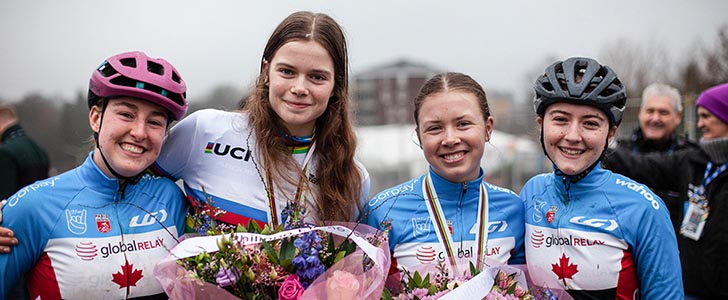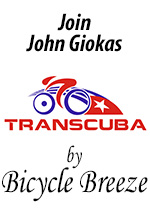August 26/04 1:58 am - Olympics: Women's MTB Preview, Interviews with Alison Sydor, Kiara Bisaro and Marie-Helene Premont
Posted by Editoress on 08/26/04
Olympics
Women's Mountain Bike Preview
Tomorrow is the women's mountain bike event, and we were up checking out the course today. We can report that it is very dusty and dry, with lots of loose, gravel sections. Not too much cover from the sun (especially after the fire, which took out a significant portion of the tree-covered section of the course). It is very hot, especially during the 11:00 to 1:00 time frame when the races will take place. Today it was at least 36C, and probably hotter on the open sections of the climbs.
To run through the course:
Course Profile
From the start the riders will do a start loop that will take about 8 minutes and climbs up an access road before looping back through the start-finish to spread out the field. From there the riders head out on the six kilometre circuit. There are two loops that bring the riders back into the start-finish area twice per lap. Each has a climb and a descent.
The circuit begins by cutting across the burned out section (which the organizers are busy bulldozing and cutting down brush to clean things up) and goes through a technical rocky section, probably the most technical section of the circuit. From there they traverse the side of the hill (along the edge of the burned section) to the first climb. This follows along the edge of a rock face, dipping in and out of singletrack, with only a short portion of the climb on a fire road where passing can take place.
At the top of this climb (the harder of the two), the riders immediately drop into the longest downhill of the course at approximately 600 metres. This is where Petra Heinz crashed and broke her ankle today. The ground is very loose small gravel - the downhill is not particularly technical, but if the riders are not careful they can easily wash out a wheel, as Heinz did.
Once they reach the bottom, they have finished the first loop and do a traverse across in front of the start-finish. This section seems to have been designed by a downhill/4-Cross aficionado, with berms, a double bump and a tabletop! After complaints from riders about launching into the air, apparently the size of the bumps was toned down.
From here the race heads out onto the second loop. There is a long gradual climb to start, with the only sustained section of passing. At the top, there is a tough little bit with probably the only portion that will force most riders to dismount; at the top of the climb they go over a drop down a chute, with an abrupt 90 degree turn to the left at the bottom leading into an immediate steep, rocky climb. In training, we saw only Miguel Martinez and Liam Killeen clear it (admittedly, we didn't stay to watch everyone). Alison Sydor, one of the best technical riders on the circuit said that she could only make it about halfway up, and, as far as she knew, none of the women could ride it. She also said that it was just quicker to get to the bottom, hop off your bike and run to the top. It could be a bottleneck if some riders decide to try and ride it and get stuck.
At this point the riders are about three-quarters of the way through a lap. They have a traverse along the side of the mountain before gradually dropping through a series of turns and singletrack and heading into the start-finish.
We do not have official word on distance, but the test event in the spring was 5 laps for women (plus the start loop), so it is hard to see it being less. This would likely make the men's race seven laps and a start loop.
Our live lap by lap coverage will start tomorrow at 4:00 am EST. Photos from today's training session to follow.
Interviews with Canada's Women's Mountain Bike Team
Canada's women's team (Alison Sydor, Marie-Helene Premont, Kiara Bisaro) is one of the favourites to put at least one rider on the podium tomorrow. The took a few minutes to speak with us on the eve of their race.
To Alison Sydor: Could you talk about the course, who it favours, what type of rider should do well?
Alison - I came here in May and rode the test event, and it has loosened up considerably since then. It is a lot more tricky and technical, with sandy, loose ground. But, we expected that this would occur, so it isn't a big surprise.
On Monday we were able to ride most of it (the organizers were still fixing the burned section), and the one change that the fire made was to take away a road section at the top and cut a new technical section, which is a net advantage for us. The other part that was affected by the fire is the forest cover, but not the trail. So, as far as affecting the course, our preparation, there has been no effect.
Who is the course going to favour?
Alison - It's the same as always; it's not about the course, it is who is best prepared, best on the day. It is not like Canadian riding, but technical is still technical, so that favours us. This is the most competitive field ever at the Olympics, I think (Sydor has competed in both previous mountain bike events at the Olympics). It is pretty demanding climbing, lots of accelerations. All things combined make it hard - it is hard not to crash, to deal with the heat, it is wearing on you.
Hardtail or soft?
Alison - Hardtail
To Kiara: This is your first Olympics, are you feeling pressure?
Kiara - I'm getting more nervous as we get closer, but it is a positive nervous; I'm trying to take it and channel it for the race. But, once I start racing I won't be so nervous.
How has it been with a veteran of Olympics like Alison?
Kiara - I'm so grateful, she's taught me so much. We became friends in the last year. Having a top rider like Alison in Canada has improved the sport immensely, and brings so many people in. We all look up to her.
How about the course for you, it is not like what you train on.
Kiara - I come from Vancouver Island - it is wet rooty, not at all like this! But I'm having fun on it. The toughest is the climbs, they are gradual, steady, with nowhere to rest. I don't think it will be won or lost in any particular spot; it is an unpredictable course. There are lots of corners, lots of ruts, braking bumps. For me, the heat hasn't been too bad, I haven't noticed it as a huge factor.
What about Lori-Ann's gold medal?
Kiara - That was so inspiring. I touched a gold medal!
Hardtail or soft?
Kiara - Hardtail
To Marie-Helene: You moved to Rocky Mountain-Business Objects part way through the season, has it been a good move?
Marie-Helene - The move to Rocky is a good move. There is better race support and experience for me.
Have you done anything different this year to prepare for the Games?
Marie-Helene - In training I didn't do anything different, I stayed with the program that works for me over the past few years. I think we (Team Canada) could do well here.
How about for you, what do you think of this course for you?
Marie-Helene - I'm a consistent rider, so i hope it will be a good race for me. I like climbing as well, so it is good for me here. The loose gravel is the hardest to deal with; we are always on the edge, so we can crash more easily. I just hope at the end of the race that I did the best I can, and gave 100%.
Who do you think the course suits?
Marie-Helene - The Euros will like this course - no roots, rocks, mud. The part that they added is better for us. Every girl here is well prepared, with good rest and training.
Hardtail or soft?
Marie-Helene - Hardtail. There is lots of climbing, it is lighter, with new lighter Marzocchi fork (we have a photo from training).
| Return to Canadian Cyclist homepage | Back to Top |





